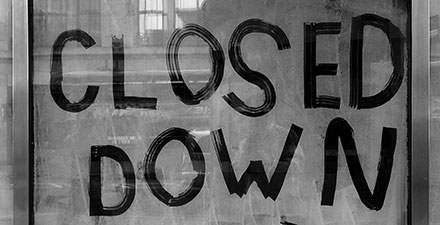How many nonprofits will shut their doors? State-level data

The whispered question continues: How many nonprofits will shut their doors because of the COVID-19 crisis? In July, we released an analysis that attempts to offer an answer to that question at the national level in the United States.
Of course, we can’t predict the future. Instead, we ran a set of 20 distinct scenarios to understand a range of possible outcomes. We’ve been gratified to see that analysis cited throughout the media and the nonprofit community. But we also recognize that national data is only of use in general terms. Most nonprofit activity is rooted in place: actual people in actual communities.
Accordingly, my colleagues Carol Brouwer and Anna Koob have re-run our analysis at the state level. This new data offers a sense of the geographic distribution of economic fragility across the nonprofit economy.
Our analysis indicates the District of Columbia is poised to lose the most nonprofits per person and Utah the fewest. The following table ranks all 50 states plus D.C. from greatest to least per capita closure. The highlighted column indicates an average across scenarios of how many nonprofits would go out of business because of the current crisis. This list is based on the same methodology we used for our national analysis.
For readers who want a closer look at the data, we have also prepared a spreadsheet with all 20 scenarios for each state and D.C. This file includes the most dire and most optimistic scenario by state as well as the number of nonprofits we analyzed in that state.
| State | Rank in per capita closure | Baseline (median) | # of nonprofits closing (median scenario) | Additional nonprofits lost because of crisis (net median) | ||||||||||
|
|
||||||||||||||
| District of Columbia | 1 | 265 | 473 | 208 | ||||||||||
| Vermont | 2 | 28 | 131 | 103 | ||||||||||
| North Dakota | 3 | 23 | 109 | 86 | ||||||||||
| Rhode Island | 4 | 34 | 151 | 117 | ||||||||||
| Maine | 5 | 51 | 183 | 132 | ||||||||||
| Minnesota | 6 | 297 | 843 | 546 | ||||||||||
| Alaska | 7 | 44 | 114 | 70 | ||||||||||
| Iowa | 8 | 117 | 415 | 298 | ||||||||||
| Massachusetts | 9 | 337 | 986 | 649 | ||||||||||
| New York | 10 | 1,046 | 2,875 | 1,829 | ||||||||||
| South Dakota | 11 | 33 | 112 | 79 | ||||||||||
| New Hampshire | 12 | 52 | 173 | 121 | ||||||||||
| Oregon | 13 | 186 | 556 | 370 | ||||||||||
| Montana | 14 | 41 | 133 | 92 | ||||||||||
| Pennsylvania | 15 | 482 | 1,558 | 1,076 | ||||||||||
| West Virginia | 16 | 60 | 207 | 147 | ||||||||||
| Maryland | 17 | 268 | 761 | 493 | ||||||||||
| New Mexico | 18 | 75 | 245 | 170 | ||||||||||
| Colorado | 19 | 316 | 780 | 464 | ||||||||||
| Connecticut | 20 | 144 | 430 | 286 | ||||||||||
| Hawaii | 21 | 65 | 176 | 111 | ||||||||||
| Wyoming | 22 | 23 | 68 | 45 | ||||||||||
| Arkansas | 23 | 103 | 325 | 222 | ||||||||||
| Nebraska | 24 | 99 | 238 | 139 | ||||||||||
| Wisconsin | 25 | 207 | 622 | 415 | ||||||||||
| Kansas | 26 | 90 | 295 | 205 | ||||||||||
| New Jersey | 27 | 342 | 962 | 620 | ||||||||||
| California | 28 | 1,525 | 4,213 | 2,688 | ||||||||||
| Missouri | 29 | 227 | 640 | 413 | ||||||||||
| Washington | 30 | 243 | 751 | 508 | ||||||||||
| Michigan | 31 | 314 | 967 | 653 | ||||||||||
| Tennessee | 32 | 243 | 688 | 445 | ||||||||||
| Ohio | 33 | 428 | 1,188 | 760 | ||||||||||
| Oklahoma | 34 | 95 | 347 | 252 | ||||||||||
| Delaware | 35 | 44 | 106 | 62 | ||||||||||
| Virginia | 36 | 317 | 860 | 543 | ||||||||||
| Georgia | 37 | 337 | 1,010 | 673 | ||||||||||
| Indiana | 38 | 223 | 640 | 417 | ||||||||||
| Illinois | 39 | 465 | 1,218 | 753 | ||||||||||
| North Carolina | 40 | 312 | 930 | 618 | ||||||||||
| Florida | 41 | 619 | 1,866 | 1,247 | ||||||||||
| Louisiana | 42 | 142 | 409 | 267 | ||||||||||
| Kentucky | 43 | 126 | 370 | 244 | ||||||||||
| South Carolina | 44 | 131 | 411 | 280 | ||||||||||
| Alabama | 45 | 111 | 376 | 265 | ||||||||||
| Mississippi | 46 | 86 | 246 | 160 | ||||||||||
| Idaho | 47 | 52 | 139 | 87 | ||||||||||
| Texas | 48 | 848 | 2,217 | 1,369 | ||||||||||
| Arizona | 49 | 157 | 500 | 343 | ||||||||||
| Nevada | 50 | 62 | 178 | 116 | ||||||||||
| Utah | 51 | 73 | 183 | 110 | ||||||||||
| Total | 12,008 | 34,374 | 22,366 | |||||||||||
It is not unusual for nonprofits to close their doors. The pandemic may add thousands of organizations to that turnover. Just how much remains to be seen. Viewing the data at the state level helps us begin to understand the consequences of nonprofit closures in communities across the country.
Notes on methodology: The full methodology can be found in the original post. Some 950 of the nonprofits in our original set are located in U.S. territories. We included them in our national analysis but not here.







Jacob Harold says:
Good question. We haven't yet run another analysis because we don't yet have a lot of new data. This analysis took the most recent data we had last year. This kind of analysis wouldn't change a lot if we re-ran it now b/c the new data would not yet reflect the impact of the crisis.
It will probably be another year until we have enough new data to be able to meaningfully say which of our scenarios was the closest approximation of what actually happened. But in the meantime, as you say, many nonprofits are struggling. Policymakers, funders, and others do see a "light at the end of the tunnel"--the challenge is that for many nonprofits the tunnel is months or years longer.
Jacob Harold
Executive Vice President, Candid
Sarah says:
Any updates to this summer data? We're hearing concerning things- policy leaders seem to think nonprofits are doing ok because of the flurry of relief dollars... unfortunately, folks have been able to limp along, but we're facing a cliff of much higher expenses and huge community need... without the commensurate funding to help us weather this.
Updated data for early 2021 would be valuable to help us accurately reflect what's going on on the ground now...
angeles, jr. magayanes says:
thanks for a great endeavor and advocacy
Lee Allen says:
On a certain level, I have to agree with H. Jackson. There are "zombie" non-profits that stumble along year after year that are either redundant or simply not needed. Unfortunately, some very valuable non-profits whose mission forces them to carry high overhead will also disappear, and I don't know how the affected clients will manage.
H. Jackson says:
Thanks for this thought-provoking article, Jacob. Frankly, I think one of the possible "benefits" of this pandemic, although it's painful short-term, is a purge of some nonprofits. There are more way more than we actually need to address societal issues. As someone who has worked in the nonprofit industry, I have send countless nonprofits hang on far longer than they should in a hand-to-mouth existence with very few societal gains to show for their work. It just becomes a funding game to keep core staff employed, existing just to exist. By weeding out the low performers, valuable resources can go to those that can demonstrate their relevance and measurable impact on the community.
K Samuels says:
Candid is addressing serious issues that are affecting nonprofits today.